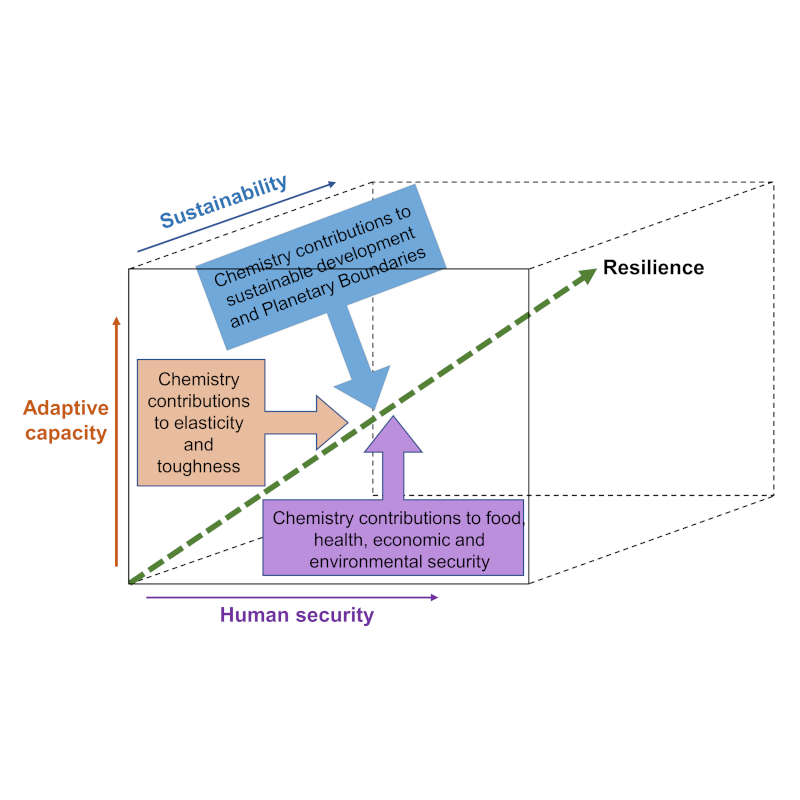A new Royal Society Open Science Perspective sheds light on how chemistry can help develop resilient systems that can ensure the sustainability of people and planet.

The COVID-19 pandemic and the process of climate change may seem very different in their causes and characteristics. These two crises belong to different sectors and operate on very different timescales, the health one moving from detection of outbreak to global emergency in a few months, while the environment one accumulates its force and impact over decades. They apparently require very different types of solutions, one rooted in public health, the other in the reduction of greenhouse gas emissions by industry, transport and agriculture. Yet, they also share a number of factors in common. Both demonstrate how a serious challenge in one sector becomes a major threat to many aspects of human security – the pandemic leading, as well as to loss of life, to massive disruptions, among others, to economies, manufacturing, agriculture transportation, food, education and livelihoods; while climate change, as well as costing lives, is having increasing impacts on, among others, health, agriculture, food, water resources, biodiversity, economies, livelihoods and the sustainability of cities.
Crucially, among the lessons from both the COVID-19 and climate change crises are the vulnerabilities of people and planet to stresses that, whether or not caused by human activity, can be much better managed; and that the most serious consequences can be avoided by better planning, preparations and readiness. In short, this means that strengthening resilience – the capacity to withstand shock without permanent deformation or rupture, or to tend to recover from or adjust easily to misfortune or change – must be central to developing systems that can ensure the sustainability of people and planet. In the case of COVID-19, there were many warnings extending over decades that a new infectious disease could be expected to appear at any time which would have the capacity to cause a pandemic with severe consequences. These warnings were not heeded and the world was not ready for the SARS-CoV-2 virus. Likewise, there have long been warnings that global warming is proceeding apace and, if unchecked, will irreversibly alter the Earth’s climate in ways that will massively impact on human beings and many other biotic species. The latest assessment from the Intergovernmental Panel on Climate Change (IPCC), released at the end of February 2022, confirms that the world is still doing far too little to avert the threat to human wellbeing and the health of the planet.
The pressing need to strengthen resilience is taken up by our group of chemists in a Perspective just published by Royal Society Open Science. As the science of transformation of matter, chemistry is necessarily at the heart of responses to vulnerability. In the case of pandemics, chemistry can directly contribute to disease defence by providing materials that can be used in pathogen detection, transmission prevention, disease diagnosis, symptom treatment and infection cure. It can also help build resilience to the consequential impacts of a pandemic – such as interruptions of supply chains and vulnerabilities to critical shortages – by providing alternate materials and processes that help to maintain diversity and redundancy. In the case of climate change, chemistry’s many roles include environmental monitoring, and the development of alternative forms of energy, manufacturing processes and products that do not release greenhouse gases into the atmosphere as well as materials that aid our adaptation to the impacts of climate change that are already unavoidable.
The Perspective, published in the Science, Society and Policy section of Royal Society Open Science, is rooted in the recognition that all three of these domains are crucial to building resilience. Adoption of resilience thinking can help guide the efforts that chemists make to provide viable solutions to reduce vulnerabilities. But others in society and in policy-making positions ultimately make the decisions on priorities for the use of resources. Representatives from all three domains need to be in dialogue if we are to be better prepared and less vulnerable in the future.

Image: Chemistry contributions to greater resilience as an outcome of strengthening adaptive capacity, human security and the sustainability of people and planet. These factors operate through multidimensional interactions among the spheres of science, society and policy (Mehta Goverdhan, Cornell Sarah E., Krief Alain, Hopf Henning and Matlin Stephen A. 2022. A shared future: chemistry's engagement is essential for resilience of people and planet. R. Soc. open sci. 9:212004212004).
If you are interested in submitting a piece of work that sits at the intersection of Science, Society and Policy, please visit the Royal Society Open Science website.

.jpg)

.jpg)

.jpg)


